You’ll create a powerful natural defense system when you plant garlic with strategic garden allies. Garlic’s sulfur compounds deter harmful pests like aphids, Japanese beetles, and spider mites while protecting companions such as tomatoes, potatoes, and roses from fungal diseases. This partnership reduces your reliance on chemical pesticides, attracts beneficial insects like ladybugs, and improves soil health through enhanced drainage and aeration. Discover how proper placement and timing can maximize these protective relationships.
Understanding Garlic’s Natural Pest Control Properties
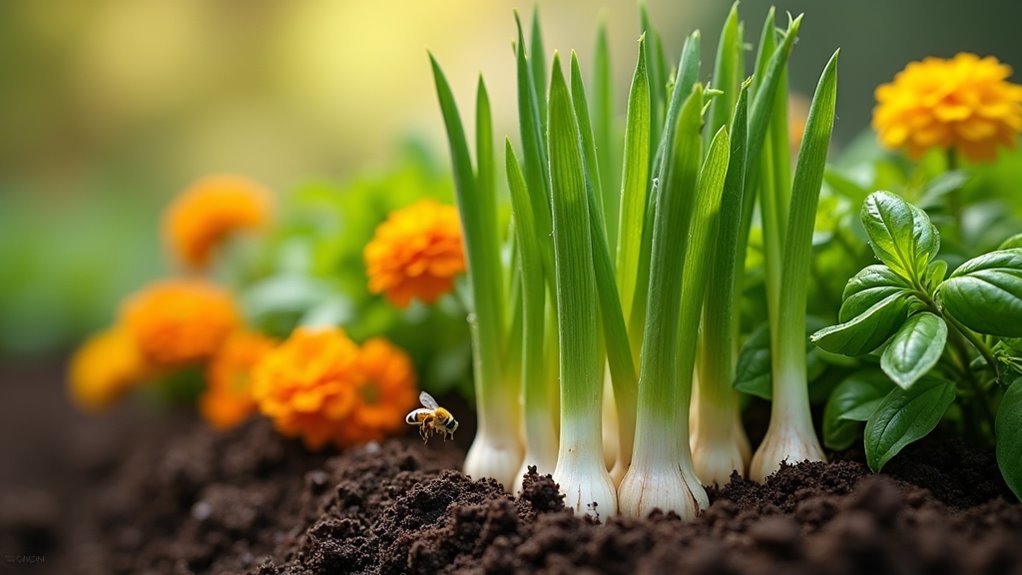
When you plant garlic in your garden, you’re introducing one of nature’s most effective pest control systems. Garlic’s potent odor acts as a powerful deterrent against harmful insects like aphids, Japanese beetles, and spider mites.
The sulfur compounds responsible for garlic’s distinctive smell don’t just enhance flavor—they function as natural fungicides that combat diseases such as powdery mildew and root rot.
Garlic’s sulfur compounds work double duty—delivering bold flavor while serving as nature’s own fungicide against garden diseases.
When you strategically position garlic as companion plants alongside vulnerable crops like tomatoes and potatoes, you create a protective barrier that promotes healthier growth.
This natural pest management reduces your reliance on chemical pesticides while encouraging beneficial insects to thrive. The result is enhanced biodiversity in your garden, where garlic works as your natural pest guardian, protecting neighboring plants from destructive invaders.
Best Companion Plants That Thrive Alongside Garlic
Strategic partnerships in the garden create thriving ecosystems where certain plants naturally complement garlic’s protective qualities.
You’ll discover that companion planting with garlic enhances your garden’s natural pest control while supporting plant health.
These proven garden allies work exceptionally well with garlic:
- Tomatoes – benefit from garlic’s protection against aphids and spider mites
- Potatoes – receive defense from harmful beetles through garlic’s strong scent
- Brassicas (broccoli, cauliflower, kale) – gain antifungal protection against powdery mildew
- Yarrow – attracts beneficial insects that serve as natural pest controllers
You’ll also find that roses thrive alongside garlic, receiving protection from aphids and fungal diseases.
These strategic partnerships maximize your garden’s productivity while reducing reliance on chemical interventions.
How Garlic Protects Roses and Flowering Plants
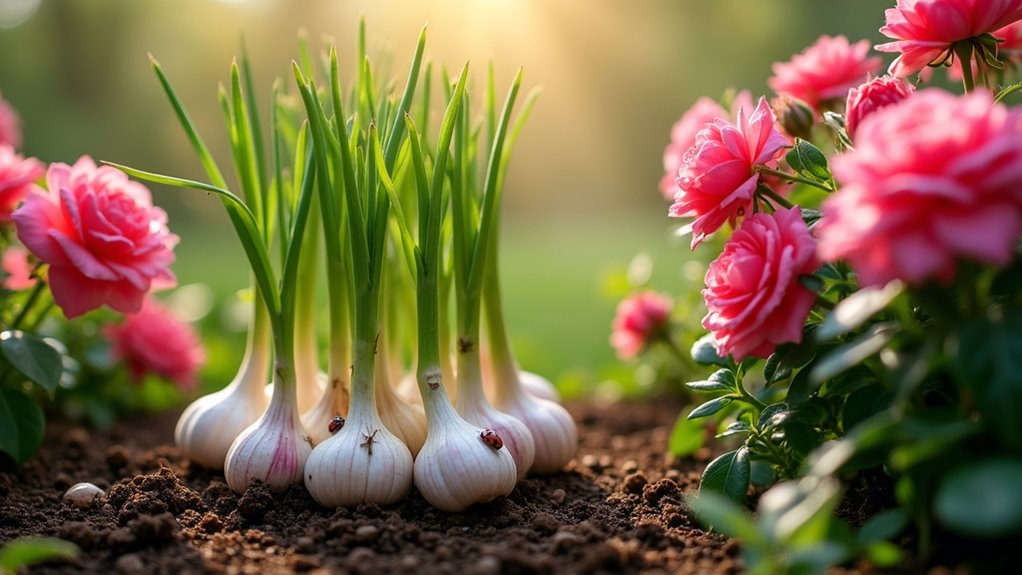
When you plant garlic near your roses and flowering plants, you’re creating a powerful natural defense system that works around the clock.
Garlic’s pungent aroma acts as an effective pest deterrent, keeping aphids and other harmful insects away from your delicate blooms.
The sulfur compounds in garlic also provide excellent protection against fungal diseases like powdery mildew, ensuring your flowers stay healthy and vibrant throughout the growing season.
Natural Pest Deterrent Properties
Because garlic releases potent sulfur compounds through its roots and foliage, it creates an invisible shield around your roses and flowering plants that naturally repels destructive pests.
This natural deterrent works continuously, making garlic an invaluable companion in your garden ecosystem.
Garlic’s pest-repelling properties deliver multiple benefits for your flowering plants:
- Aphid Control – The strong sulfur scent confuses and drives away aphids that typically damage rose buds and leaves
- Fungal Disease Prevention – Sulfur compounds act as natural fungicides, protecting against common plant diseases
- Pollinator Protection – Reducing harmful insect populations creates safer environments for beneficial bees and butterflies
- Chemical-Free Solution – Eliminates need for synthetic pesticides while maintaining healthy garden conditions
This companion planting strategy enhances your garden’s natural defense system.
Fungal Disease Prevention Benefits
While garlic’s pest-repelling abilities protect your roses from destructive insects, its antifungal properties create an even more thorough defense system against the fungal diseases that devastate flowering plants.
Garlic’s sulfur compounds function as natural fungicides, preventing powdery mildew and root rot from taking hold in your garden. When you plant garlic near roses, you’re reducing your reliance on chemical treatments and embracing organic gardening practices.
The sulfur that garlic accumulates in soil creates lasting protection for neighboring plants, establishing a healthier growing environment.
You’ll notice fewer fungal diseases affecting your flowering plants as garlic’s strong odor deters pests that typically introduce these infections. This companion planting strategy strengthens your garden’s natural resilience while promoting biodiversity.
Strategic Placement of Garlic in Vegetable Gardens
Although garlic’s culinary value often takes center stage, its strategic placement throughout your vegetable garden can transform it into a powerful ally for pest control and plant health.
When planting garlic as companion plants, you’ll maximize its ability to deter pests while enhancing neighboring crops.
Position garlic strategically using these key placements:
- Near nightshades – Plant around tomatoes and potatoes to repel aphids and Japanese beetles.
- Alongside brassicas – Surround cabbage, broccoli, and kale for natural pest protection.
- Around fruit trees – Create protective barriers that guarantee healthier yields.
- Between carrot rows – Enhance flavor and promote mutual growth benefits.
Garlic’s strong scent creates an effective natural defense system, while its roots break up compacted soil, improving nutrient absorption for surrounding plants throughout your garden ecosystem.
Plants to Avoid When Growing Garlic
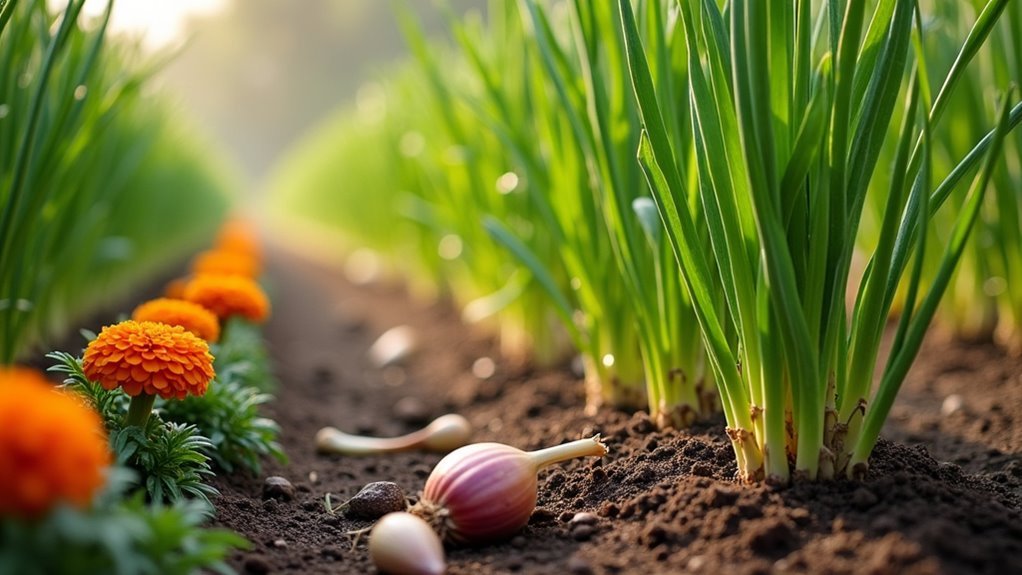
While garlic offers many companion planting benefits, you’ll want to steer clear of certain plants that don’t play well together.
Legumes like beans and peas suffer stunted growth when planted near garlic, making them poor garden neighbors.
You’ll also notice that herbs like sage and parsley can experience altered flavors and reduced vigor when grown too close to your garlic beds.
Legumes and Growth Issues
Despite garlic’s reputation as a beneficial companion plant, it can seriously harm certain crops in your garden. When you plant garlic near legumes like beans and peas, you’ll likely encounter significant growth issues that reduce your harvest quality and quantity.
Garlic’s potent chemical compounds create several problems for legumes:
- Stunted development – Your beans and peas won’t reach their full growth potential.
- Reduced yields – You’ll harvest fewer pods and smaller crops overall.
- Compromised nitrogen-fixing – Garlic interferes with legumes’ natural ability to enrich soil.
- Poor plant health – Your legumes will struggle to thrive and resist diseases.
You’ll need strategic garden planning to prevent these negative interactions. Keep garlic separated from your legume crops to guarantee both plant types flourish independently.
Flavor Alteration Risks
Beyond stunting growth, garlic’s intense aromatic compounds can fundamentally alter the taste profiles of nearby herbs and vegetables. When you plant garlic too close to sage and parsley, these culinary favorites lose their distinctive flavors, becoming compromised by garlic’s overpowering presence.
This creates a domino effect in your kitchen garden, where herbs you’ve carefully cultivated for specific recipes no longer deliver their intended taste.
Understanding these flavor alteration risks helps you choose better companions for garlic. Instead of placing it near delicate herbs, position garlic away from plants whose flavors you want to preserve.
Strategic spacing prevents your sage from tasting like garlic-infused versions of themselves, ensuring each plant maintains its unique culinary value for your cooking needs.
Garlic’s Role in Soil Health and Fungal Disease Prevention
As garlic grows throughout the season, it accumulates sulfur compounds in the surrounding soil, creating a natural fungicidal environment that actively combats diseases like powdery mildew and root rot.
This soil health enhancement makes garlic an invaluable companion plant that produces lasting benefits beyond your harvest.
Your garden ecosystem transforms when you incorporate garlic strategically:
Strategic garlic placement creates a thriving garden ecosystem where natural soil enhancement and disease prevention work together seamlessly.
- Sulfur accumulation acts as a continuous soil treatment that’ll prevent fungal diseases from establishing.
- Improved soil structure breaks up compaction, enhancing drainage and aeration for neighboring plants.
- Reduced chemical dependence supports organic gardening practices by naturally controlling disease pressure.
- Enhanced plant resilience creates healthier growing conditions that boost overall garden immunity.
You’ll notice surrounding plants develop stronger natural defenses against common fungal threats when garlic’s antifungal properties maintain ideal soil conditions.
Maximizing Garden Space Through Garlic Companion Planting
When garden space becomes precious, garlic transforms into your secret weapon for maximizing every square foot through strategic companion planting.
You’ll discover that interplanting garlic cloves with tomatoes, potatoes, and brassicas creates a natural pest-repelling barrier while utilizing both vertical and horizontal space effectively.
Your garden benefits from garlic’s deep root system, which improves soil structure and creates well-aerated, nutrient-rich conditions for neighboring plants to thrive.
Attracting Beneficial Insects With Garlic Plant Partnerships
You’ll discover that garlic’s strong scent works as a magnet for beneficial insects like ladybugs and lacewings, turning your garden into a natural pest control system.
When you create strategic partnerships between garlic and companion plants, you’re building the perfect habitat for predatory insects that’ll hunt down aphids and caterpillars.
Your garlic plantings become powerful pollinator attractors that establish a thriving ecosystem where beneficial bugs can flourish and protect your crops.
Garlic’s Natural Pollinator Appeal
While most gardeners think of garlic primarily as a pest deterrent, this pungent bulb actually serves as a powerful magnet for beneficial insects that’ll transform your garden into a thriving ecosystem.
Garlic’s natural pollinator appeal stems from its strong scent, which attracts beneficial insects like bees and ladybugs that naturally control common garden pests.
This aromatic ally creates remarkable advantages for your garden:
- Enhanced pollination rates for neighboring flowering plants through increased beneficial insect diversity
- Boosted pollinator attraction when companion planted with nasturtiums and marigolds
- Increased predatory insect populations that manage pest problems naturally
- Improved overall garden health by fostering beneficial insect relationships
You’ll discover that garlic doesn’t just protect itself—it actively enhances your entire garden’s productivity and ecological balance.
Beneficial Bug Habitat Creation
Beyond attracting individual beneficial insects, garlic creates extensive habitat zones that transform scattered garden visitors into permanent residents.
When you interplant garlic with flowering companions like yarrow and chamomile, you’re establishing diverse microenvironments that support thriving beneficial insect populations. These habitats encourage ladybugs, lacewings, and other pest predators to stay longer and reproduce in your garden.
Garlic’s dual role as both beneficial insect magnet and deterrent pests creates balanced zones where helpful species flourish while harmful ones retreat.
This strategic planting approach reduces your reliance on chemical interventions by letting nature handle pest control naturally. You’ll foster ecosystem health through biodiversity, as these established beneficial insects maintain ongoing pest management while supporting overall plant health and garden productivity.
Predatory Insect Attraction Methods
Strategic partnerships between garlic and specific companion plants amplify your garden’s ability to draw in predatory insects through targeted attraction methods.
When you implement companion planting strategies with garlic as your foundation, you’ll create powerful insect-attracting combinations that enhance natural pest control.
These proven methods maximize predatory insect attraction:
- Plant yarrow near garlic to provide essential nectar sources for ladybugs and lacewings.
- Add chamomile alongside garlic rows to create supplementary feeding stations for beneficial insects.
- Combine garlic with tomatoes and peppers to leverage garlic’s pest-repelling properties while attracting predators.
- Establish diverse plantings around garlic to maintain balanced ecosystems supporting long-term predator populations.
You’ll notice increased beneficial insect activity as garlic’s strong scent works synergistically with companion plants, creating an effective biological pest control system.
Seasonal Timing for Optimal Garlic Companion Planting
Timing your garlic planting determines both the success of your crop and the effectiveness of your companion plants. You’ll achieve peak growth by aligning your garlic’s seasonal needs with compatible plants that share similar timing requirements.
Fall planting from October to November allows garlic to develop robust root systems before winter, while companion plants like onions and carrots can be established simultaneously. Spring planting offers flexibility from January to March, though you’ll get smaller cloves than fall-planted varieties.
| Season | Garlic Planting | Companion Plants |
|---|---|---|
| Fall | October-November | Onions, Carrots |
| Spring | January-March | Lettuce, Spinach |
| Summer | Harvest Time | Tomatoes, Peppers |
Coordinate your planting schedule with your area’s last frost date to guarantee both garlic and companions thrive together throughout their growing seasons.
Creating a Balanced Garden Ecosystem With Garlic Allies
When you integrate garlic into your garden’s companion planting system, you’re establishing a natural defense network that strengthens your entire growing space. This strategic approach creates synergistic relationships that benefit all plants involved.
Garlic’s ecosystem contributions include:
- Natural pest deterrent – Reduces chemical pesticide dependency while protecting allies like tomatoes and brassicas from aphids and spider mites.
- Soil enhancement – Accumulates sulfur that acts as a fungicide and improves nutrient availability for surrounding plants.
- Biodiversity promotion – Attracts beneficial insects for pollination and pest control, creating garden resilience.
- Yield optimization – Maximizes overall garden productivity through companion planting synergies.
You’ll find that garlic’s sulfur compounds don’t just repel pests and diseases—they actively improve soil quality, making nutrients more accessible to neighboring plants and fostering a thriving, interconnected garden ecosystem.
Frequently Asked Questions
What Is the Companion Planting of Garlic?
You’ll strategically place garlic near compatible plants like tomatoes, potatoes, and brassicas. Garlic’s strong scent repels pests, enhancing neighboring crops’ growth while avoiding beans, peas, and asparagus that don’t thrive nearby.
What Is the Enemy of Garlic?
You’ll find garlic’s enemies include legumes like beans and peas, asparagus, other alliums such as onions, sage, and delicate herbs like parsley that suffer altered flavors when planted nearby.
Should You Plant Garlic With Tomatoes?
You should plant garlic with tomatoes because garlic repels harmful pests like aphids, prevents fungal diseases, enhances tomato flavor, and both plants thrive in similar growing conditions together.
What Should You Not Plant After Garlic?
You shouldn’t plant beans, peas, asparagus, sage, parsley, or strawberries after garlic. These plants can experience stunted growth, altered flavors, or reduced yields due to garlic’s lingering compounds in the soil.
In Summary
You’ll transform your garden into a thriving ecosystem by strategically planting garlic with the right companions. You’re not just growing individual plants—you’re creating natural partnerships that’ll protect against pests, attract beneficial insects, and maximize your harvest. Don’t overlook garlic’s power as a garden ally. Start planning your companion plantings now, and you’ll see how this simple bulb can revolutionize your entire growing space while boosting productivity naturally.

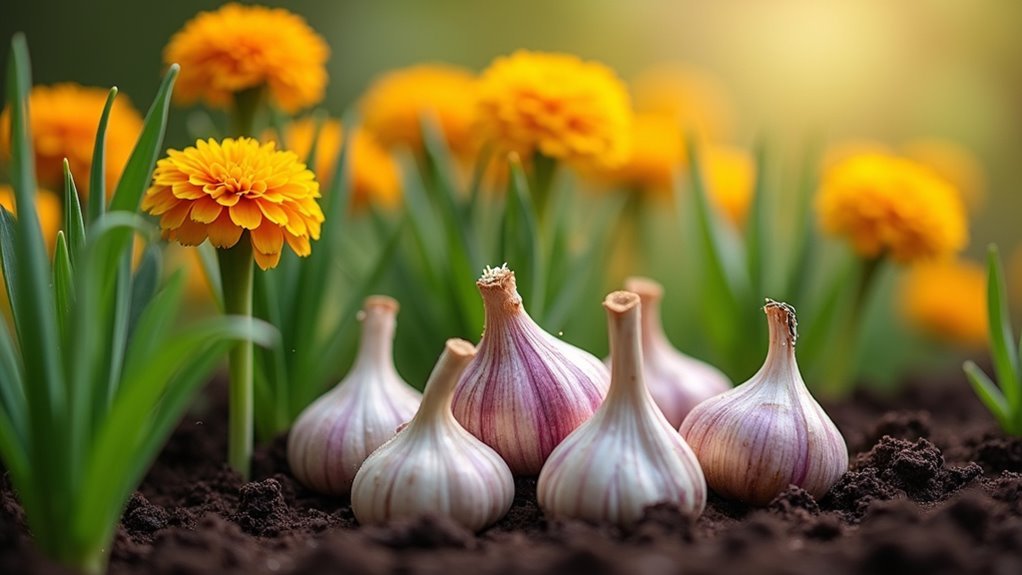
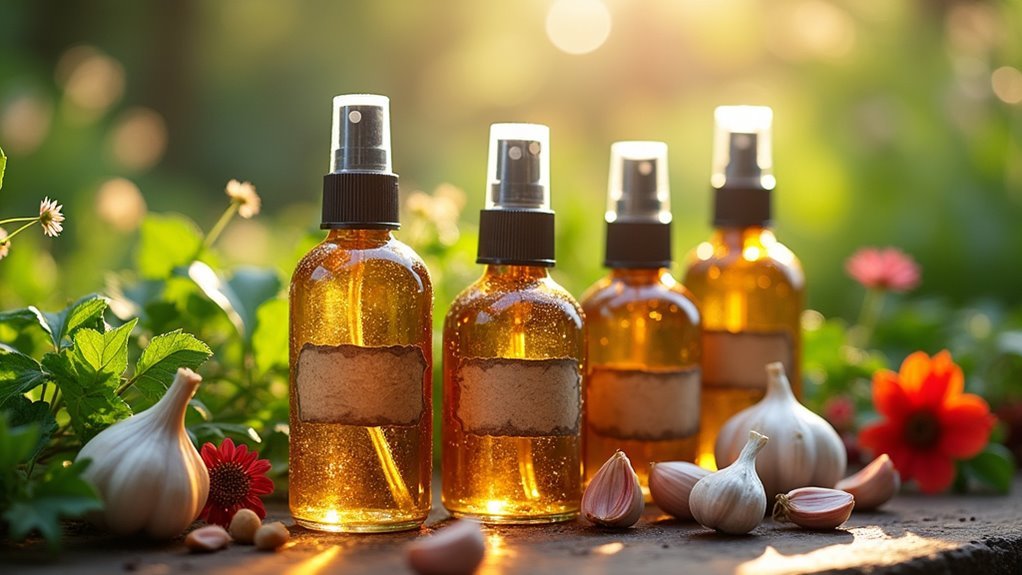
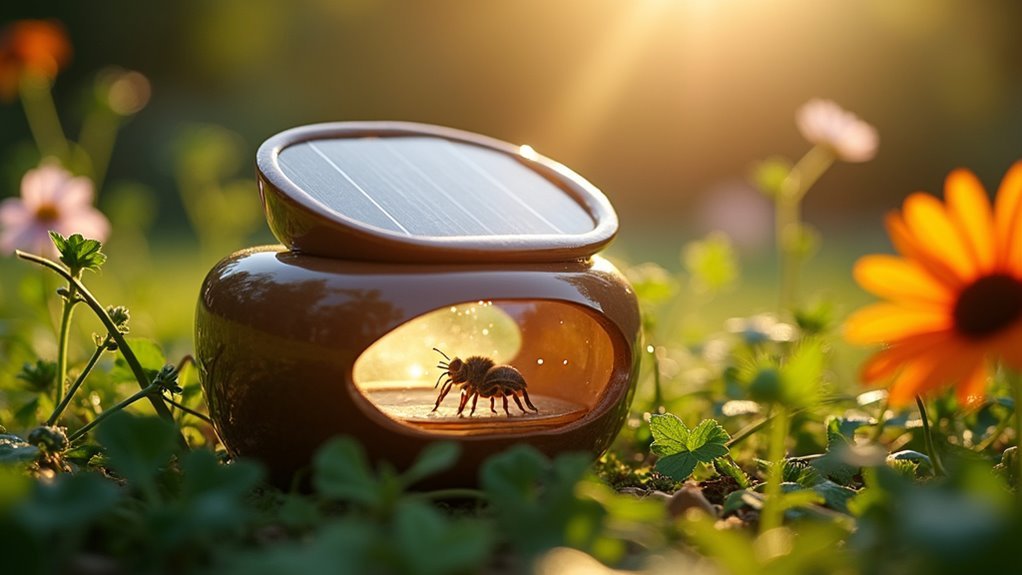

Leave a Reply